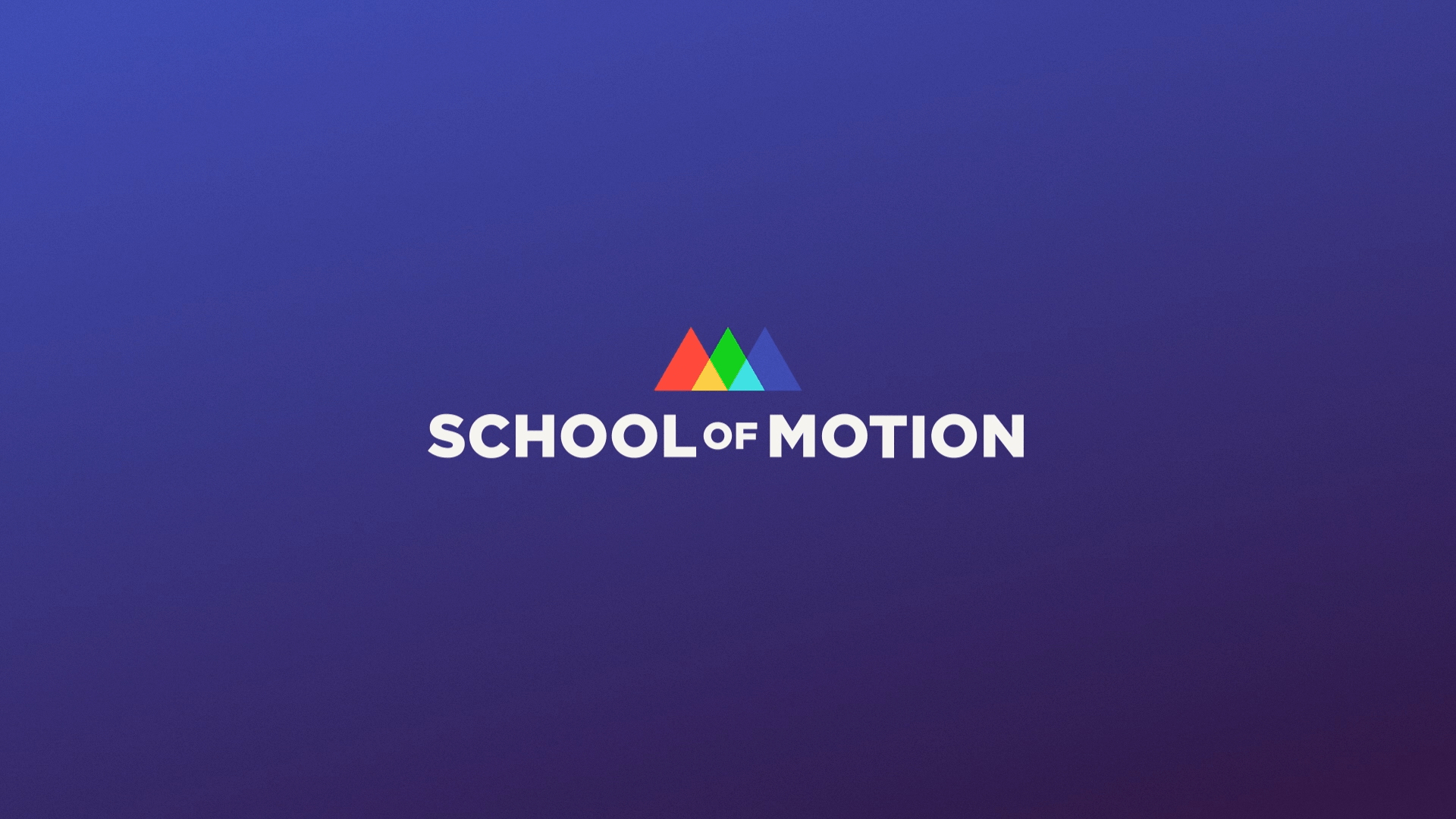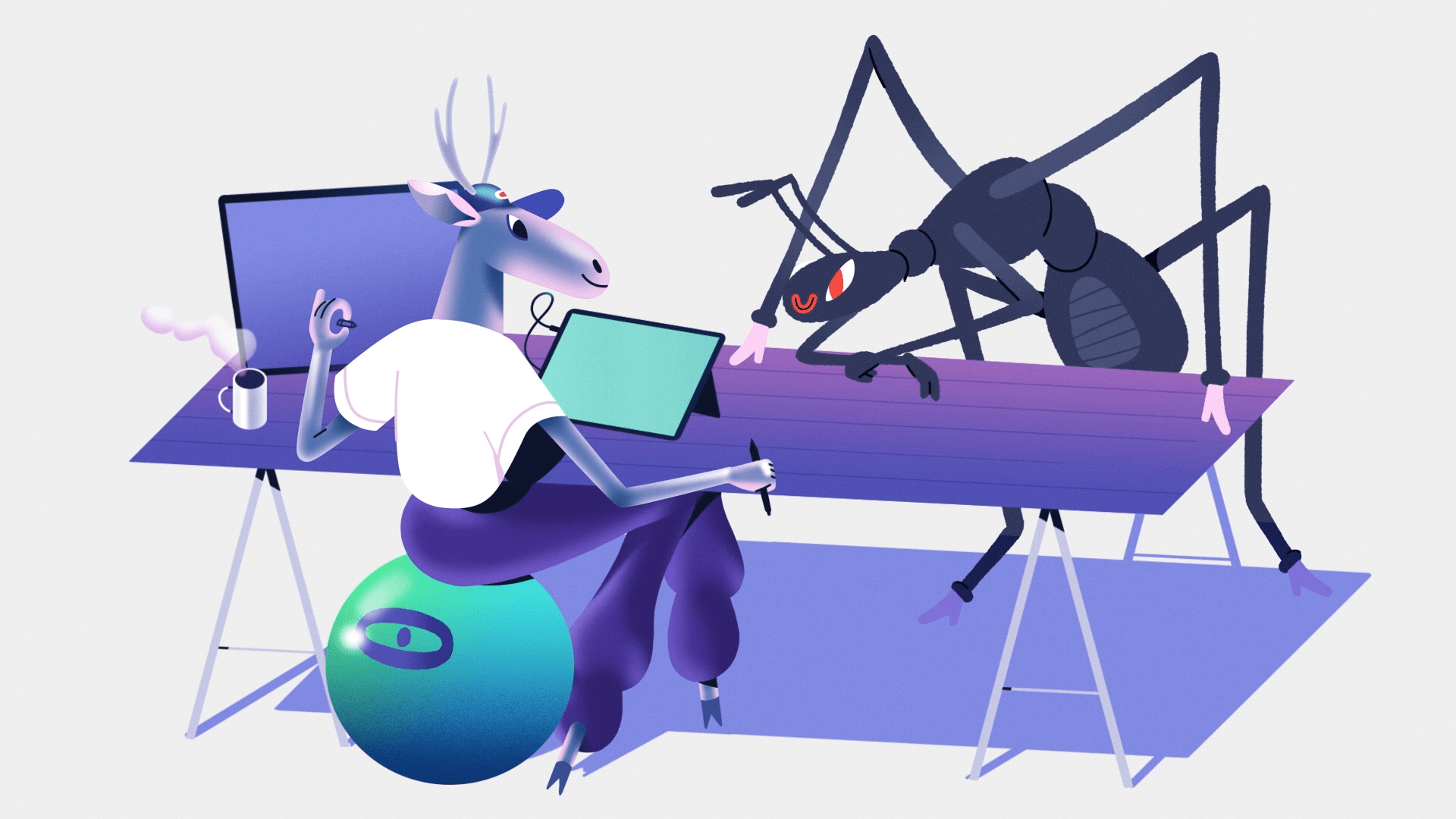As you’ll almost certainly see at some point today, School of Motion teamed up with Ordinary Folk to bring you the new “Join the Movement” video.
It won’t be a surprise that the video is stunning. This piece is like the culmination of all the current trends in the motion design field at this moment. You name it, it’s in there, and what’s more, done to perfection. As Joey puts it, it’s a “mograph manifesto” and I’m sure one that will be referenced to no end.
While the work itself is amazing, what I find so excited about this collaboration is what it represents. Two upstarts, paving their own path and finding success along the way.
Unless you’ve been hiding under a rock, you’ve no doubt witnessed Joey and School of Motion’s meteoric rise these past few years. They’ve transformed from yet another AE tutorial site to the behemoth they are now, not just producing world-class educational material but to now also sharing the love and commissioning artists along the way to make work like this.
And with Ordinary Folk, Jorge has long been the people’s champ of the motion design community and has deeps roots with Wine After Coffee and Blend. And now, through Ordinary Folk, he has an outlet for his and his team’s creative vision. And from the looks of it, they don’t seem to be compromising.
It’s all very exciting and in this Q&A we chat with both Jorge and Joey about their new collaboration and what each of these two titans is up to next.
Q&A with Jorge Rolando Canedo Estrada of Ordinary Folk
First, congrats on the amazing new project! I feel like this will be equal parts catching up on how Ordinary Folk has been doing as well as learning more about your recent project with School of Motion.
To get things going, how have things been over at Ordinary Folk?
First of all, thank you for all the love you and Motionographer have shared with the launch of the studio, and for featuring this video as well. It’s an honour to be here amongst such insane talent!
We are so thankful – things have been going great. It’s crazy to think we’ve been “official” for half a year now. There’s 4 of us full-time now, but we’ve also been able to work with a lot of really amazing freelancers, and every project so far has been wonderful in one way or another, so we can’t complain. Well actually, both Greg and Victor manage to beat me at Mario Kart consistently, so there’s that.
I know Ordinary Folk is pretty new but what have been some of the challenges, if any, of starting a new studio?
I was very cautious (or maybe “afraid” is a better word) of making the jump into a forming a ‘real studio’ so it was all very gradual and organic, which I think helped me with facing the challenges one by one as they came and ensuring I had a well-defined answer to ‘why start a studio?’.
All the steps, from starting to hire freelancers for increasingly more projects, to being responsible for someone else’s living and their family as I offered Victor a full-time job, to make the jump of adding to the team another animator, Greg, who also helps with leading projects, to eventually making our part-time and remote studio producer, Stefan, full-time with us – all these things took a lot of prayer, thinking and preparation. They also all came at different times, which helped by giving us the opportunity to take them one at a time and not get overwhelmed by them.
And even with our various projects, they’ve gradually become more complex, so we’ve been able to manage them as they come.
After all of this, I think one of the most challenging things for me has been to make sure we’re taking the right steps in terms of growth, both in number of people sitting here and in kinds of projects, but also the right steps in terms of making sure that the team feels fulfilled and taken care of, and that we all have a good work/life balance (most of the time). All of this is helped by knowing when to say no to projects that might compromise all of the above, but also by always asking the team when considering projects that will affect this balance, and ensuring we’re all in the same boat when it happens, so it’s not a surprise and we’re all prepared. This is one of the many things I learned from Jay during my time at Giant Ant – he was so considerate about asking us before taking on various projects, and this is something I hope I’m passing on to my team now. I’m learning things by trial and error (and believe me, there’s a lot of error), but I would join all the other studio owners out there in saying that the hardest thing is finding the balance between keeping people happy, having cool projects and still making a living out of it.

Looking at the “Join the Movement” video, how did that all come about and what was the team like for this one? From the outside, this seems kind of like a dream project and I imagine it came with a lot of freedom. What was the initial brief like?
Joey has been a friend for a long time now, and he reached out to us with an email that read:
“…after the first night of the very first Blend, you and I were walking around downtown and you told me you were going to open your own studio. I told you I wanted to be one of your first clients… maybe could jam on some sort of “mograph manifesto” of sorts. Well, 4 years later here we are.”
To which I replied
“…are you sure you want US to do this?”
I mean, we’re just starting out as a studio, and to get an ask like this was truly an honour, and, honestly, hard to believe. But we all got super excited from the moment we received the email, and we were game for the challenge.
We knew Joey wanted us to make something we were proud of, so in many ways, we had the creative freedom to create something special but we also had this crazy pressure in the back of our minds, since we knew this video was, in many ways, for the motion design community. So we decided to own it and even put in our own resources to get it where we wanted it to be because projects like this don’t come along every day.
Concept
We knew from the beginning that we wanted to showcase 1) a visual progression in terms of complexity and 2) different techniques, but without making it feel too much like a montage where every shot was totally disconnected.
For this to be possible, we knew right away that we had to team up with some amazing designers. But first, we had to get the message right. So we asked Joey and team a whole bunch of questions and, working closely with Julie Rybarczyk, the copywriter for the project, we set out to make it sound awesome. After a few different versions, we landed on the script.
Design
Then we brought in Loris F. Alessandria to start helping with some boards, and later on, we had both Jay Quercia and Nuria Boj also explore some of the same boards to see how ideas could evolve from one designer to the next, even in the storyboard phase. By the end of it, we had a board that had ideas from everyone in it, and we were very excited about it – maybe too excited to see how complicated it would be to pull it off.
The same designers divided and conquered to finish the styleframes, all following the same colour palette and constantly giving each other feedback and building upon each other’s frames. It was an awesome process to be a part of, and Jay Quercia had a special role in it, constantly trying to unify the piece as a whole, creating colour scripts, always coming up with new ideas and designing most of the final styleframes.
Animation
Ok, now how on earth are we going to animate all of these?!”
That was the first thing we asked ourselves, and it might be my favourite question that is asked in a project, because I know that by asking this, we will be taken to places we haven’t been before, and no matter what happens, we’ll learn something new.
We had characters, and not only that but 3D characters, two things we’ve had very little experience with – heavily stylized 3D, 2D and 3D elements combined, flying dragons and even a giant ant talking to a buck! (Get it?)
We started by establishing an animation mood by working on the shots that were shape-heavy, Victor, Greg and myself first started taking shots, spending more than a week on each to make sure they were awesome. We also had our awesome intern at the time, Joélie Sémoulin, start on some shots before her internship was over (we miss you Joélie!). This all led us to soon realize we were going to need A LOT more help to finish it. And we had some very special helpers ready to jump in.
At the beginning of the project, Joey made it clear that he really wanted to feature actual students that worked on the piece, so we decided to make them part of the animation team and hand them shots that they would be in charge of making spectacular. So we had Taylor J. Peters, Deanna Reilly, Francisco M. Quiles N. and Abbie Bacilla starting on their shots as well.
And to complete the team, we brought in Jordan Bergren, Manuel Neto, Claudio Salas, and Jose Peña to help us take this to the finish line. Just the animation phase took us one month, and when we finished it, we could barely believe that we had actually finished it.
Sound
Of course, no piece is ever done without the other 50% (often more) that makes it awesome, so we knew that we wanted to work with one of our favourite composers, the one and only Ambrose Yu. We brought him in as soon as the script was done, to help us find the right voice and to help establish the music. We didn’t have many ideas for it, but for some reason, Casualty by Lawrence seemed to have the right vibe, so we kind of used that as our mood direction.
We had a lot of back and forth to make the music and the visuals match as much as possible since we strongly believe the two should be connected to make something special, and Ambrose totally killed it, as always.

There will always be money maker projects so when something like this comes around, I imagine it can be in stark contrast with the typical advertisements. What were your main hopes in taking on this project?
We’ve only been a studio for a little while, so, while there’s certainly been ‘money projects’, there haven’t been many. But the kind of work we’ve done most of has been more creative, so this video doesn’t feel like a stark contrast compared to many of our other projects. But it definitely was a contrast in the sense that we really wanted to push ourselves into uncharted territories and, looking back, I have to say this is one of the pieces I’m most proud of as a team, because I could see every person in the team “scared” of their shots, but still going for them and doing an awesome job, even if it took multiple tries. This really pushed us to styles and techniques we hadn’t done before, with a fairly tight timeline, and I think we got it there.
Finally, looking toward the future, what type of work do you want to see Ordinary Folk doing in the coming months and years?
Definitely more projects like this, the kinds that terrify us a little, with messages that we can get behind, and also that allow us to work closely with the client to make something special. We don’t often have a specific project or client in mind, but rather a way of working that will allow us to make projects like this possible, as well as maintaining a healthy work/life balance.
But again, we’ve only been around for a few months so we’re still in the honeymoon period. Maybe ask us next year!

Q&A with Joey Korenman of School of Motion
Congrats on the shiny new video and School of Motion’s seemingly never-ending momentum! How have things been and what has changed since we last heard from you?
Thank you so much. Things have been going really well this year, with lots of growth and fun new things in the works. We’ve started the process of ramping up a 3D curriculum, with the help of our new Creative Director, the one and only EJ Hassenfratz. We launched a new class that we’re really proud of, Illustration for Motion, taught by the brilliant Sarah Beth Morgan. We’re launching some new classes in the winter and spring that will help round out some learning paths, and we just had the absolute dream experience of working with the amazing team over at Ordinary Folk and their roster of collaborators.
We’ve also more than doubled our team size this year and have been figuring out how to manage all of this growth. It’s been an inspiring, challenging, mind-blowing year.
In addition to all of that, Tool released its first album in 13 years — and it’s everything I hoped it would be :)

The new film is pretty spectacular, what do you hope the viewers learn or gain from watching it?
All of the credit goes to Jorge and his team. They put so much love into this piece, and I can’t thank them enough for bringing this to life.
We commissioned this piece for a few reasons. First off, we recently worked with our good buddies at Blind/The Futur to help us update our branding. Through that process, we also honed in on our mission and messaging, and we realized our current site and branding don’t really tell the School of Motion story in a clear enough way. Our company has grown, morphed and adapted so much over the last four to five years that we lost that cohesive look and feel, or brand voice.
We’re in the middle of a total site redesign based on the new branding, which we expect to launch in a few months, and we decided to go big by commissioning a piece that represents our true vision: as a viable and attractive alternative to traditional education in the field of Motion Design.
Our hope with this piece is that it will inspire a new generation of artists to give Motion Design a shot, and to do it without going hundreds of thousands of dollars into debt. We have many alumni already out in the industry working at the highest levels, and some of them have had no “formal” training other than our courses. We even asked Ordinary Folk if they’d be comfortable working with some of our alumni on this video, and they booked four of them as freelancers on the project! Greg Stewart, one of the artists at OF, is also an alumni and a teaching assistant for us.
I wanted this video to be our planting of the flag, so to speak. We have built a very unique educational platform that mixes scalable learning with human interaction, critique, and a vibrant community of fellow learners. This is a new phase for us, and we wanted to let the world know.

I imagine being in this position through School of Motion is a bit surreal. You used to be on the box working for clients and now you are the client. What is one thing you have to remind yourself of in these scenarios?
To be honest, everything about School of Motion is surreal to me. I remember working on projects at Toil, my old studio, and watching the stuff Jorge was working on at Buck and then at Giant Ant. My animators and I were enormous fans, so being able to get to know him over the years has been a huge privilege.
A few years ago, he told me he was thinking of opening a studio. I told him that I’d love for School of Motion to be one of his first clients, but at the time neither of us were ready to actually make that happen.
This year, the timing was right, and I got to check off a bucket-list item by working on this project with my Motion Design hero and his amazing studio. I can’t speak highly enough of the whole team over there, and the process was incredibly smooth.
Being on the other end of the client-vendor relationship is really interesting. I’d like to think that we’re a “good client” in the sense that we really do understand the process and respect how long things take to produce. The hardest thing for me was remembering that we need this video to effectively communicate our brand message. The design and animation are so beautiful that it was hard for me sometimes to give feedback other than “holy crap, keep going.”
There was one section of the piece in which we call out the individual alumni who worked on the piece, and it wasn’t quite working. We went through several rounds of revisions to get to the final version, and I felt so guilty asking Jorge to keep trying again. I’ve been on the other end of that scenario, when the client isn’t quite happy yet but doesn’t really know what to tell you and you’re trying option after option. I know that it can be a little frustrating, and I really didn’t want to put the OF team through a million revisions, but I did need the piece to accomplish a specific goal — so I kept pushing until it was right.
Jorge and the team made everything so easy, and they were a dream to work with, so the revisions were no problem, but I was hyper-aware of what I was asking for and tried to be as helpful a client as possible.
The other thing I wanted to do was to let Ordinary Folk just do their thing. So many of the projects I worked on in my career started off with incredible creative potential but got watered down by the client revision process. I knew that too many cooks in the kitchen could kill some of the magic, so I put a ton of trust in Jorge to lead this thing in the right direction.
There were a few times when he’d say something like, “don’t worry, we’re gonna make this look cool,” and I couldn’t really see what he was seeing. His vision was very clear, and mine was a little fuzzy. I had to let go of that urge that all clients feel at one point or another to insert themselves into the process, and to simply have faith in the studio we were working with. I think this philosophy had a huge impact on the process, as well as the final result.

Looking toward the future with School of Motion, what’s next?
We’re on a mission to create a soup-to-nuts curriculum that will let anyone, anywhere in the world, get a world-class education in Motion Design.
We’re slowly but surely filling in the gaps in our learning path and finding new ways to add value for our students and alumni. This year, we brought on Brittany Wardell, our Student Experience Lead. She’s focused on making sure our students are getting the most out of our classes, and she’s also starting to network with studios and companies that have been reaching out in search of quality Motion Designers. We want to do more when it comes to helping our alumni find gigs after taking our classes.
I’m also really humbled by how amazing our team is. School of Motion is a really tight-knit company, and I feel like everyone I work with is family. Alaena, EJ, Zach, Caleb, Ryan, Phil, Amy, Reaghan, Kaylee, Jeahn, Hannah, Brittany, Shelby, and all of our instructors, developers, motivators and teaching assistants — I’m honored to be on this rocket ship with all of them. And, I know we’ll be growing even more in the next year.
I’m looking forward to seeing what we can accomplish with our dream team.
Finally, what would you say the ratio is of the number of miles you run compared to the number of emails you send in a given week?
I run a fair amount — sometimes up to 50 miles a week… but emails dwarf that number! RIP my inbox :)
Credits
Directed by Ordinary Folk
Creative Direction: Jorge R. Canedo E.
Production: Stefan Green
Script: Julie Rybarczyk
Design: Jay Quercia, Nuria Boj, Loris F. Alessandria
Animation: Jorge R. Canedo E., Victor Silva, Greg Stewart, Joélie Sémoulin, Jordan Bergren, Manuel Neto, Claudio Salas, Jose Peña
Featuring Animation from SOM Alumni: Taylor J Peters, Deanna Reilly, Francisco M. Quiles N., Abbie Bacilla
Music & SFX: Ambrose Yu
School of Motion production team: Joey Korenman, Reaghan Puleo






